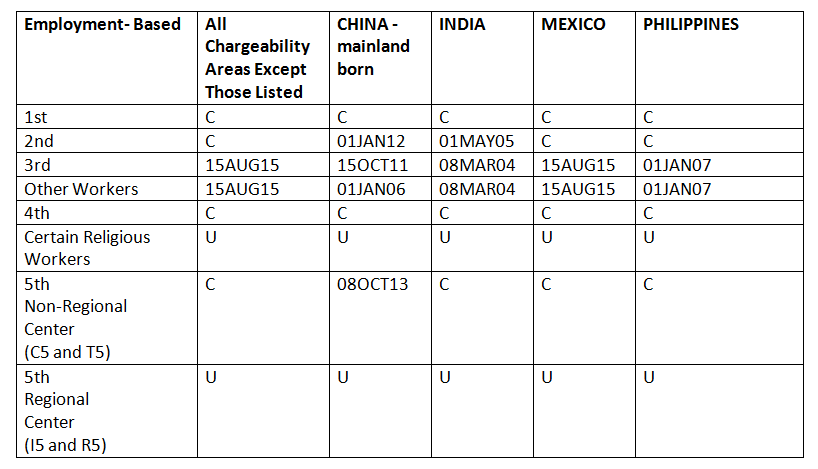September 9, 2015, brought great excitement to many foreign nationals—particularly nationals of India, China, and the Philippines—who were anxiously awaiting the opportunity to file their Adjustment of Status applications with USCIS several years earlier than expected so they could secure independent work authorization and travel permission while waiting to obtain their green cards. Just five days before the start of October, the Department of State (DOS) published a revised October 2015 Visa Bulletin (Revised Bulletin) that supersedes the previously published Original Bulletin. The sudden revision has caused significant headache and anger among affected foreign nationals, particularly nationals of China and India, who viewed the Original Bulletin as a much needed step forward in their journey to become Lawful Permanent Residents (Green Card holders). Subsequently, 14 adversely affected Indian and Chinese Nationals have filed a class action lawsuit against the DOS, USCIS and several government officials in federal court in the State of Washington, stating that the sudden change to the visa bulletin just five days before the start of October violates affected foreign nationals’ due process rights and is in contravention of the Administrative Procedure Act. It is possible that plaintiffs in this case may claim reliance damages from USCIS having incurred significant costs in attorneys’ fees and in obtaining required medical examinations in preparation for filing their Adjustment of Status applications on October 1, 2015.
The dates published in the October Visa Bulletin were revised following “consultations” with the DOS, Department of Homeland Security and USCIS. A similar breakdown in intra-agency communication between the DOS and USCIS took place in July 2007, when the DOS announced in the Visa Bulletin that green cards were available to certain categories of skilled workers, only for USCIS to insist on a revision of those dates a few days later. In 2007, under the pressure of Congress and the threat of lawsuits, USCIS ultimately agreed to honor the original bulletin allowing for originally eligible applicants to file their Adjustment of Status applications.
The Revised October 2015 Visa Bulletin appears as follows, with the revisions noted in bold:
Dates for Filing Applications Chart

Application Final Action Dates Chart. No revisions were made to this chart by the Revised Visa Bulletin.

The “Dates for Filing Applications” chart is months/years ahead of the “Application Final Action Dates” chart in most employment-based classifications. Here are the pertinent revisions broken down by Country of Origin:
India
A comparison shows that for EB-2 India, the Dates for Filing Applications Chart (July 1, 2009) is roughly 4 years faster than under the Application for Final Action Dates Chart (May 1, 2005). The Revised Bulletin, however, shaved off 2 years of eligible applicants for Dates of Filing, which originally allowed for applicants with a priority date of July 1, 2011, to file Adjustment of Status applications under the Original Bulletin. For EB-3 India, there is no change to the Revised Bulletin.
China
Similarly, the Dates for Filing Applications Chart for EB-2 China was revised, whereas, for EB-3 China, the Dates for Filing Applications was left unchanged. For EB-2 China, the Dates for Filing Applications Chart (January 1, 2013) is 1 year faster than the Application Final Action Dates Chart (January 1, 2012). When compared to the Original Bulletin, the Revised Bulletin shows that the priority date for EB-2 China was pushed back approximately 16 months—from May 1, 2014 to January 1, 2013.
Philippines
The Dates for Filing Applications Chart took the biggest step back for EB-2 and EB-3 Philippines. Under the Original Bulletin, USCIS would accept Adjustment of Status applications for filing with a priority date of January 1, 2015. Under the Revised Bulletin, the priority dates for both EB-2 and EB-3 were revised to January 1, 2010—a difference of 5 years. The Application Final Action Dates Chart remained unchanged for EB-2 and EB-3 Philippines, showing a priority date of January 1, 2007 for both categories.
Next steps for employers
In light of the Revised Bulletin, employers must reassess those employees who were eligible to file Adjustment of Status applications based on the original October 2015 Visa Bulletin to identify any potential applicants who are no longer eligible to file Adjustment of Status Applications come October 1. Any applications received by USCIS where the priority date is not current based on the Revised Bulletin will be rejected and returned to foreign national applicants or their representatives. Employers should take the following steps in light of this late revision in the process for determining visa availability:
-
Make sure all employees who were eligible to apply for Adjustment of Status applications under the Original Bulletin are still eligible under the Revised Bulletin.
-
File Adjustment of Status applications for anyone who is current.
-
Some employees will have priority dates eligible for Adjustment of Status in October 2015, but who are no longer in the sponsored position, either because they have changed roles with the sponsoring employer or because they are no longer employed by the sponsoring employer. These individuals cannot apply for Adjustment of Status. Employers must be prepared to address this issue and understand the potential need to immediately initiate new green card processes for the individuals, as these individuals may want to convince employers to file Adjustment of Status applications as soon as possible even though they no longer hold the sponsored position.




 />i
/>i


